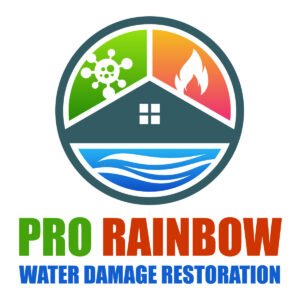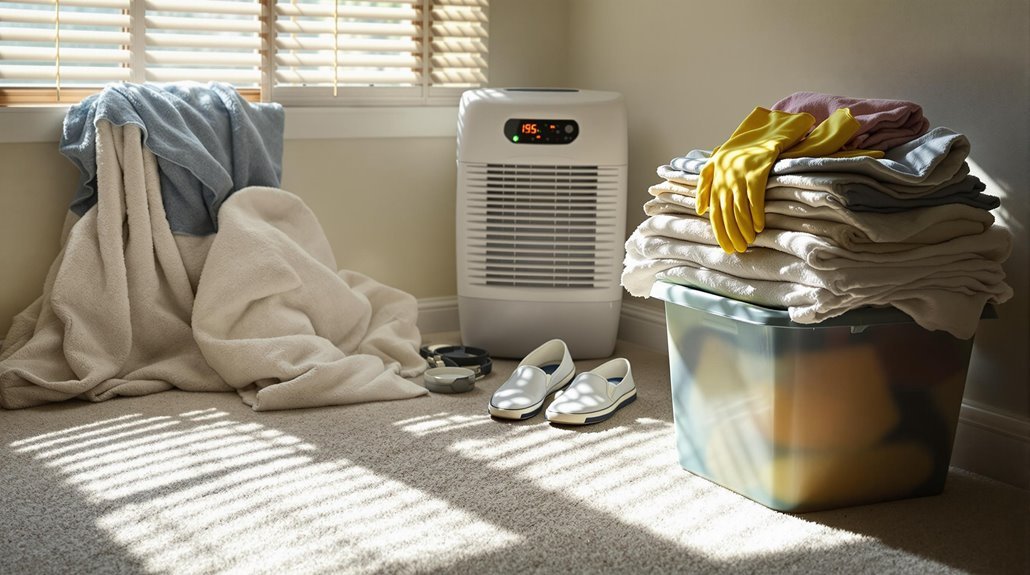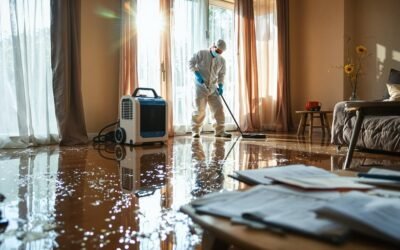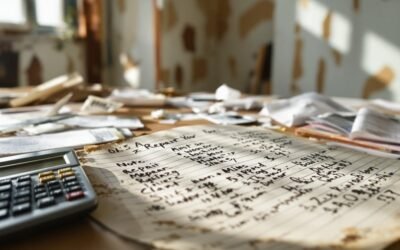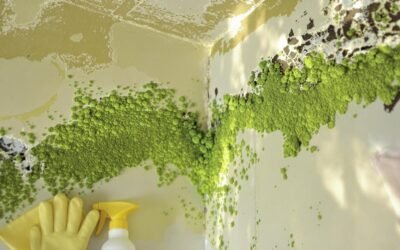After water damage, act quickly to minimize costs. Start by evaluating the damage and determining the severity. Shut off the water supply to prevent further flooding. Document everything with clear photos and notes for your insurance claim. Remove standing water using a wet/dry vacuum or sump pump, and dry out affected areas with fans and dehumidifiers. Raise furniture to improve airflow, and monitor humidity levels to inhibit mold growth. Taking these immediate actions not only safeguards your property but likewise streamlines the claims process, ensuring you secure the compensation you deserve. There's more to uncover about effective recovery methods.
Key Takeaways
- Quickly assess the damage using moisture detection tools and document findings for insurance claims.
- Immediately shut off the water supply to prevent further flooding and damage.
- Remove standing water using a wet/dry vacuum or sump pump to minimize additional harm.
- Dry out affected areas with fans and dehumidifiers to prevent mold growth and speed up restoration.
- Keep thorough records of damage, repairs, and conversations with insurance for a smoother claims process.
Assess the Damage

As soon as you find water damage, it's crucial to assess the extent of the harm before taking further steps. Start with a thorough damage evaluation, inspecting affected areas for visible signs like discoloration, warping, or mold. Use moisture detection tools, such as moisture meters, to identify hidden damp spots within walls or flooring. These tools help you determine the severity and scope of water intrusion, allowing you to prioritize your response effectively. Document your findings with photographs and notes, as this information can be invaluable for insurance claims or future repairs. By taking these proactive measures, you can minimize further damage, ensuring a more efficient restoration process and potentially reducing costs in the long run. Additionally, swift action during the assessment phase is essential to prevent mold growth and ensure a thorough recovery.
Shut Off Water Supply
Once you've assessed the damage, the next step is to shut off the water supply to prevent any further flooding or moisture intrusion. Locate the main water shut-off valve, usually found near your water meter or where the water line enters your home. Turn the valve clockwise until it's fully closed. This immediate response is vital in minimizing additional damage and costs. If you're unable to locate the valve or if it's stuck, consider calling a professional plumber for assistance. Remember, acting quickly can greatly reduce the extent of the water damage and the subsequent repair expenses. Always prioritize safety and make certain that everyone in your household is aware of the emergency response actions taken. Additionally, prompt water removal can help mitigate damage and safeguard your property from advanced restoration techniques.
Document Everything

To effectively manage the aftermath of water damage, documenting everything is essential. Start by taking clear, high-quality photographs of the affected areas. Capture the extent of the damage, including structural issues, personal belongings, and any standing water. This photographic evidence will be critical for your claim documentation. Make certain to date and label each photo for easy reference. Moreover, keep records of any conversations with insurance agents, repair contractors, or emergency services, noting dates and details. Collect all receipts related to temporary repairs or mitigative actions you take. By maintaining thorough documentation, you'll not only streamline the claims process but also help guarantee you receive the compensation you deserve.
Remove Standing Water
Swiftly removing standing water is vital in minimizing further damage and preventing mold growth. Start by employing effective water extraction methods to eliminate excess moisture. Use a wet/dry vacuum or a sump pump, depending on the volume of water. If the situation is severe, consider contacting professionals who specialize in moisture removal.
| Equipment | Purpose | Tips |
|---|---|---|
| Wet/Dry Vacuum | Extract small amounts | Confirm proper filtration |
| Sump Pump | Remove large volumes | Position correctly |
| Towels & Mops | Final moisture removal | Use absorbent materials |
Dry Out Affected Areas

Begin the drying process immediately to prevent further damage and inhibit mold growth. Start by using fans and dehumidifiers strategically placed in the affected areas. These drying techniques improve moisture control and promote faster evaporation. Open windows to increase air circulation, but only if the outside humidity is low. Remove soaked carpets and fabrics, as they can retain moisture, leading to mold issues. If possible, raise furniture to allow airflow underneath. Monitor humidity levels with a hygrometer, aiming for a range between 30% and 50%. Regularly check for hidden moisture in walls and floors, using moisture meters if necessary. Your proactive approach to drying will greatly reduce long-term costs and protect your home from further complications.
Contact Professionals
After evaluating the severity of the water damage, it's essential to choose qualified professionals who can effectively address the situation. You'll want to request immediate assistance to prevent further complications and guarantee a thorough recovery process. Acting swiftly will help mitigate damage and restore your space more efficiently.
Assess Damage Severity
Evaluating the severity of water damage is critical to determining the appropriate response and recovery measures. Start with a thorough damage assessment, inspecting all affected areas, including walls, floors, and ceilings. Look for signs of mold, structural damage, or compromised electrical systems. A detailed severity evaluation helps you decide whether you can handle the situation yourself or if you need to call in professionals. Documenting the damage with photos can likewise assist in insurance claims, so don't skip this step. The quicker you assess the situation, the more effectively you can mitigate further damage and reduce overall costs. Remember, addressing severe damage promptly can save you time, money, and stress in the long run.
Choose Qualified Experts
Once you've assessed the extent of the water damage, it's time to choose qualified experts to help you restore your property. Start by looking for professionals with relevant expert qualifications, such as certifications in water damage restoration and mold remediation. Check their experience and client reviews to ascertain they have a solid track record. When you contact potential hires, ask about their specific methods and equipment. This not only shows their expertise but likewise helps you gauge their professionalism. Furthermore, request a detailed estimate to compare costs and services. Hiring tips like verifying insurance and licensing can protect you from future headaches. By choosing the right experts, you'll minimize costs and improve the efficiency of your restoration process.
Request Immediate Assistance
As soon as you recognize the signs of water damage, it's essential to contact professionals without delay. Doing so not only helps mitigate further damage but can likewise assist with insurance claims. Emergency services can provide immediate support, ensuring your home is safe and secure.
Consider the following when reaching out:
- Expert Assessment: Professionals can quickly assess the full extent of the damage.
- Fast Response: Quick action reduces the risk of mold growth and structural issues.
- Proper Equipment: They have specialized tools for effective water extraction and drying.
- Documentation for Insurance: Experts can help document damage, supporting your insurance claims process.
Conclusion
By taking immediate action after water damage, you can greatly reduce costs and prevent further issues. Have you considered how quickly mold can develop in damp areas? Acting fast to assess the damage, shut off the water supply, and document everything will set you on the right path. Don't hesitate to reach out to professionals if needed; their expertise can save you time, money, and further headaches in the long run. Protect your home and your peace of mind.
